Social Responsibility: Regulations, Practices, and Case Analysis
VerifiedAdded on 2022/09/27
|9
|1000
|23
Report
AI Summary
This report analyzes social sustainability regulations and practices, focusing on the impact of social responsibility acts on businesses. It examines how organizations can create a positive image by adhering to these regulations and ensuring their operations do not harm society. The report highlights the use of global guidelines to prevent child labor and promote fair labor practices. It discusses the importance of higher wages in reducing child labor and improving family incomes. Additionally, the report emphasizes corporate community involvement programs and the role of culture in shaping labor practices, along with the CRAP model to assess the reliability of the study. The report explores the economic situations, health, and safety concerns that affect labor practices. It draws on various sources, including Harvard Business Review articles and academic publications, to support its findings.
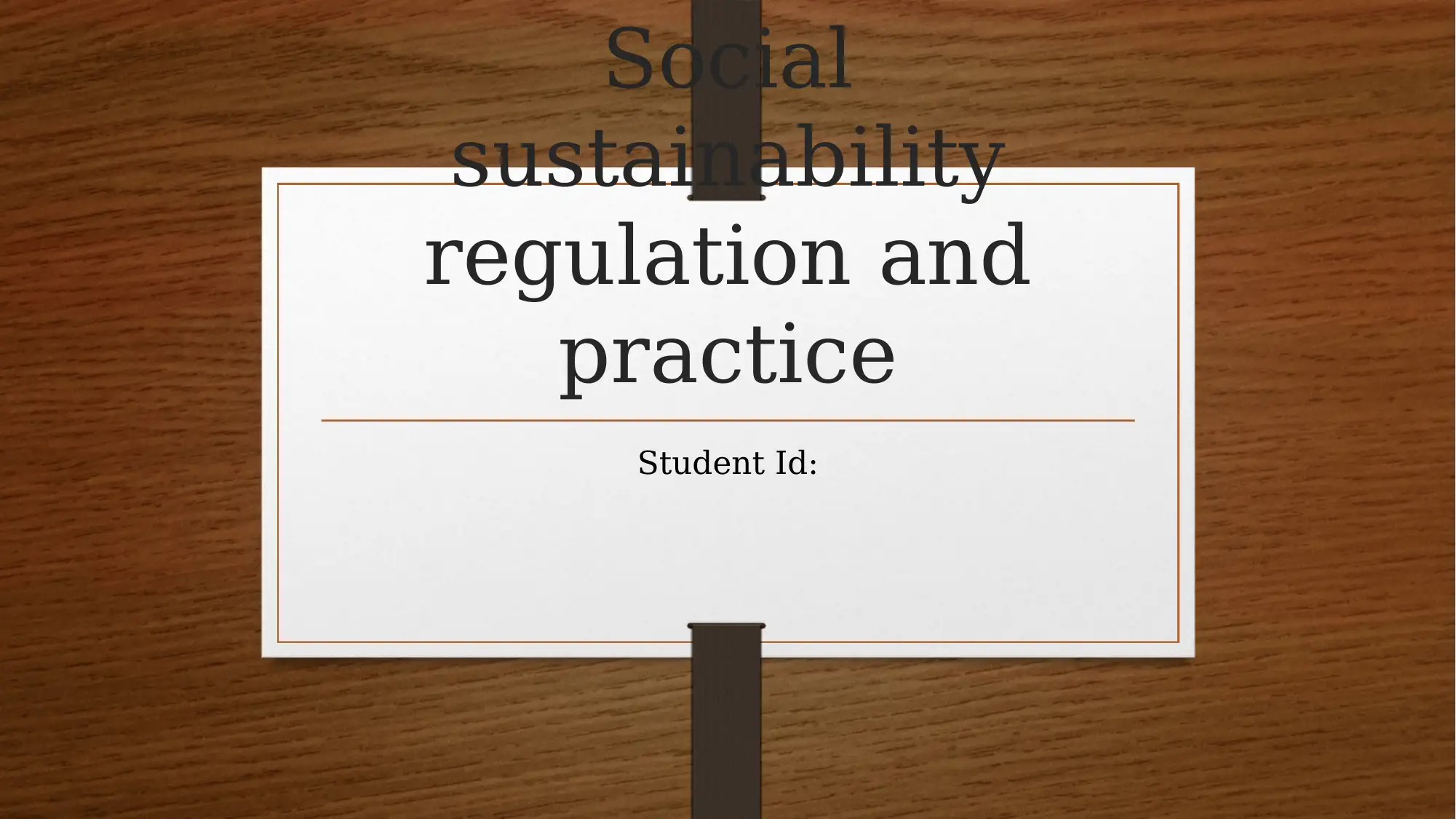
Social
sustainability
regulation and
practice
Student Id:
sustainability
regulation and
practice
Student Id:
Paraphrase This Document
Need a fresh take? Get an instant paraphrase of this document with our AI Paraphraser
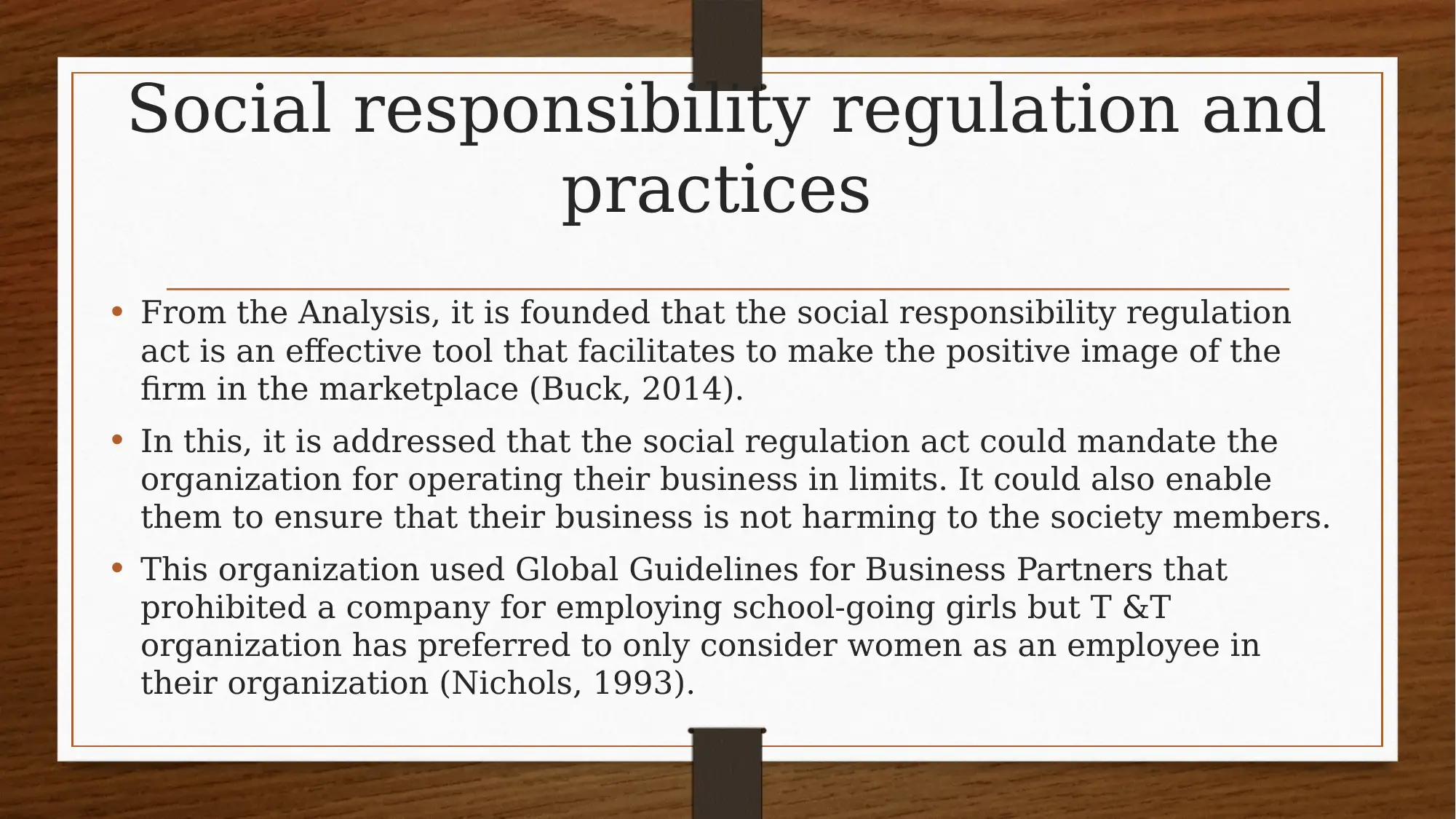
Social responsibility regulation and
practices
• From the Analysis, it is founded that the social responsibility regulation
act is an effective tool that facilitates to make the positive image of the
firm in the marketplace (Buck, 2014).
• In this, it is addressed that the social regulation act could mandate the
organization for operating their business in limits. It could also enable
them to ensure that their business is not harming to the society members.
• This organization used Global Guidelines for Business Partners that
prohibited a company for employing school-going girls but T &T
organization has preferred to only consider women as an employee in
their organization (Nichols, 1993).
practices
• From the Analysis, it is founded that the social responsibility regulation
act is an effective tool that facilitates to make the positive image of the
firm in the marketplace (Buck, 2014).
• In this, it is addressed that the social regulation act could mandate the
organization for operating their business in limits. It could also enable
them to ensure that their business is not harming to the society members.
• This organization used Global Guidelines for Business Partners that
prohibited a company for employing school-going girls but T &T
organization has preferred to only consider women as an employee in
their organization (Nichols, 1993).
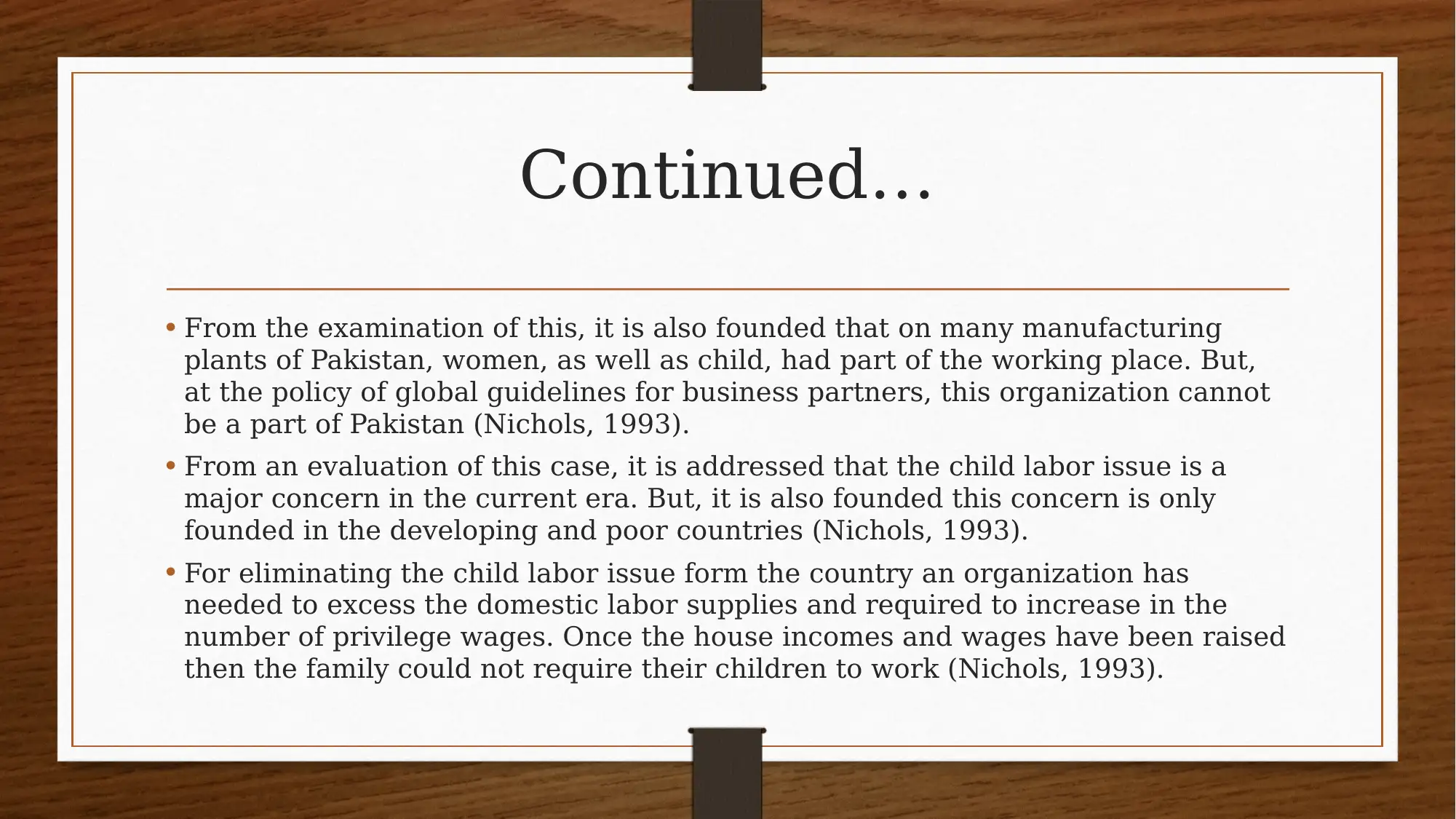
Continued…
• From the examination of this, it is also founded that on many manufacturing
plants of Pakistan, women, as well as child, had part of the working place. But,
at the policy of global guidelines for business partners, this organization cannot
be a part of Pakistan (Nichols, 1993).
• From an evaluation of this case, it is addressed that the child labor issue is a
major concern in the current era. But, it is also founded this concern is only
founded in the developing and poor countries (Nichols, 1993).
• For eliminating the child labor issue form the country an organization has
needed to excess the domestic labor supplies and required to increase in the
number of privilege wages. Once the house incomes and wages have been raised
then the family could not require their children to work (Nichols, 1993).
• From the examination of this, it is also founded that on many manufacturing
plants of Pakistan, women, as well as child, had part of the working place. But,
at the policy of global guidelines for business partners, this organization cannot
be a part of Pakistan (Nichols, 1993).
• From an evaluation of this case, it is addressed that the child labor issue is a
major concern in the current era. But, it is also founded this concern is only
founded in the developing and poor countries (Nichols, 1993).
• For eliminating the child labor issue form the country an organization has
needed to excess the domestic labor supplies and required to increase in the
number of privilege wages. Once the house incomes and wages have been raised
then the family could not require their children to work (Nichols, 1993).
⊘ This is a preview!⊘
Do you want full access?
Subscribe today to unlock all pages.

Trusted by 1+ million students worldwide
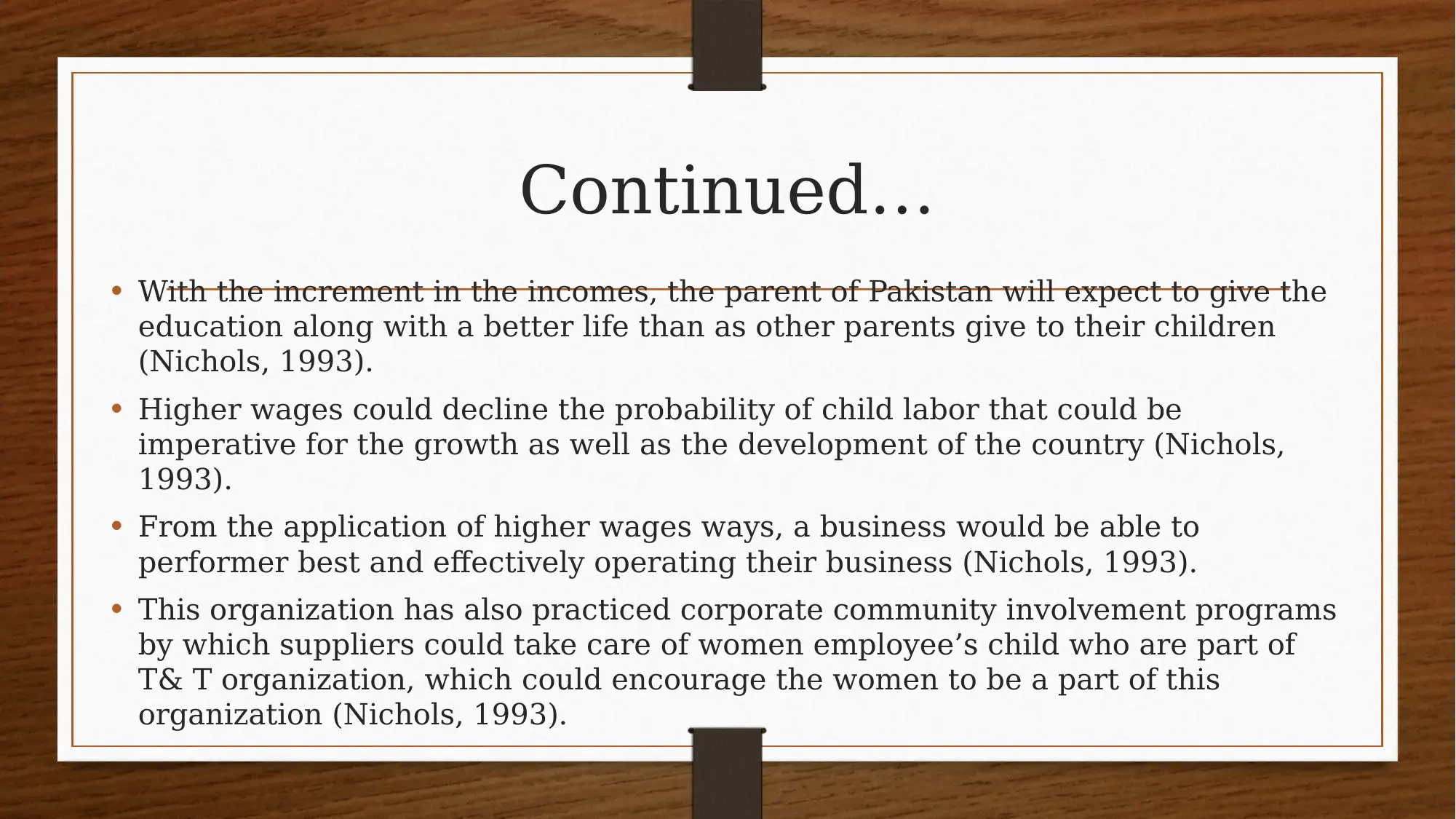
Continued…
• With the increment in the incomes, the parent of Pakistan will expect to give the
education along with a better life than as other parents give to their children
(Nichols, 1993).
• Higher wages could decline the probability of child labor that could be
imperative for the growth as well as the development of the country (Nichols,
1993).
• From the application of higher wages ways, a business would be able to
performer best and effectively operating their business (Nichols, 1993).
• This organization has also practiced corporate community involvement programs
by which suppliers could take care of women employee’s child who are part of
T& T organization, which could encourage the women to be a part of this
organization (Nichols, 1993).
• With the increment in the incomes, the parent of Pakistan will expect to give the
education along with a better life than as other parents give to their children
(Nichols, 1993).
• Higher wages could decline the probability of child labor that could be
imperative for the growth as well as the development of the country (Nichols,
1993).
• From the application of higher wages ways, a business would be able to
performer best and effectively operating their business (Nichols, 1993).
• This organization has also practiced corporate community involvement programs
by which suppliers could take care of women employee’s child who are part of
T& T organization, which could encourage the women to be a part of this
organization (Nichols, 1993).
Paraphrase This Document
Need a fresh take? Get an instant paraphrase of this document with our AI Paraphraser
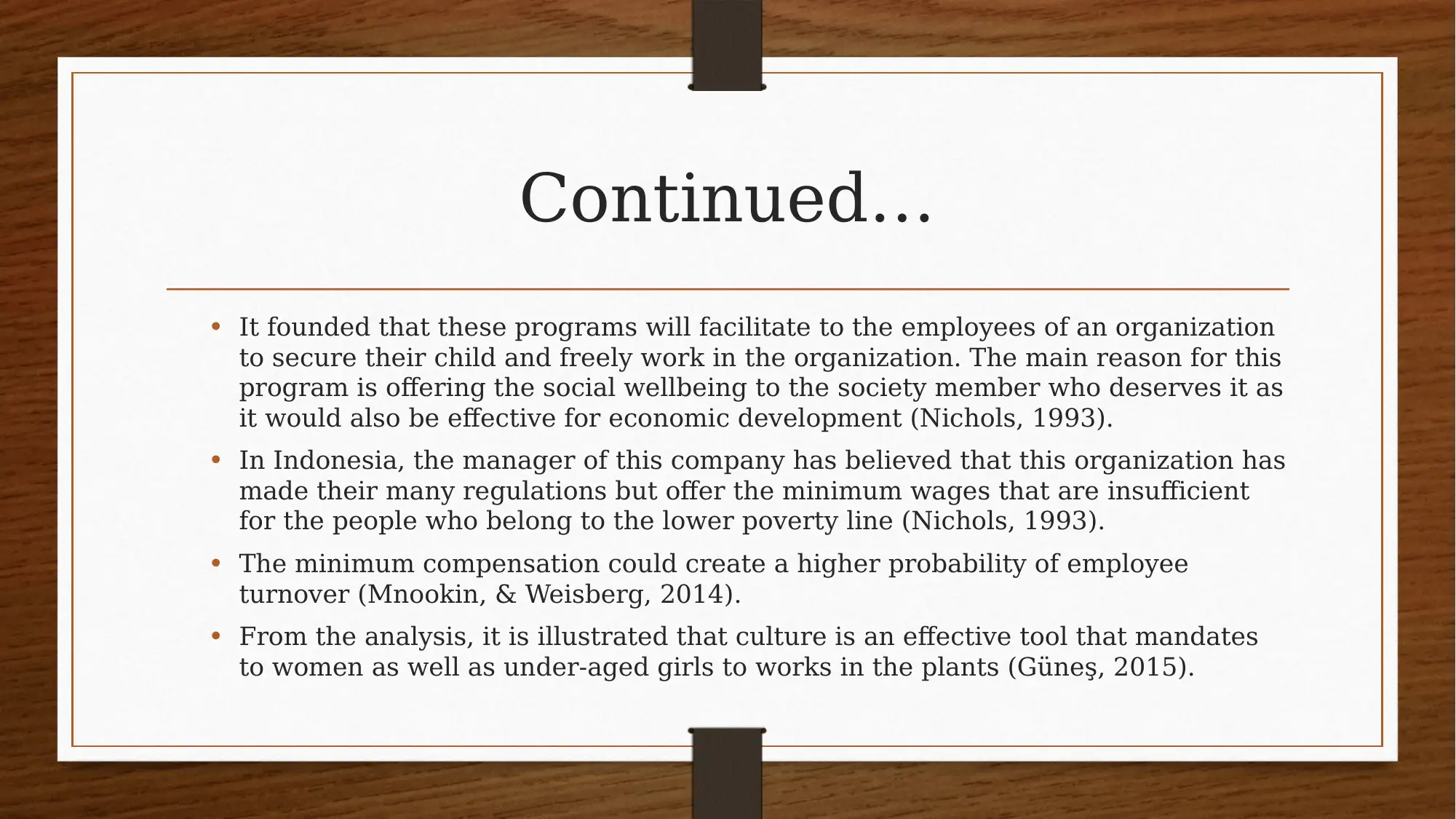
Continued…
• It founded that these programs will facilitate to the employees of an organization
to secure their child and freely work in the organization. The main reason for this
program is offering the social wellbeing to the society member who deserves it as
it would also be effective for economic development (Nichols, 1993).
• In Indonesia, the manager of this company has believed that this organization has
made their many regulations but offer the minimum wages that are insufficient
for the people who belong to the lower poverty line (Nichols, 1993).
• The minimum compensation could create a higher probability of employee
turnover (Mnookin, & Weisberg, 2014).
• From the analysis, it is illustrated that culture is an effective tool that mandates
to women as well as under-aged girls to works in the plants (Güneş, 2015).
• It founded that these programs will facilitate to the employees of an organization
to secure their child and freely work in the organization. The main reason for this
program is offering the social wellbeing to the society member who deserves it as
it would also be effective for economic development (Nichols, 1993).
• In Indonesia, the manager of this company has believed that this organization has
made their many regulations but offer the minimum wages that are insufficient
for the people who belong to the lower poverty line (Nichols, 1993).
• The minimum compensation could create a higher probability of employee
turnover (Mnookin, & Weisberg, 2014).
• From the analysis, it is illustrated that culture is an effective tool that mandates
to women as well as under-aged girls to works in the plants (Güneş, 2015).
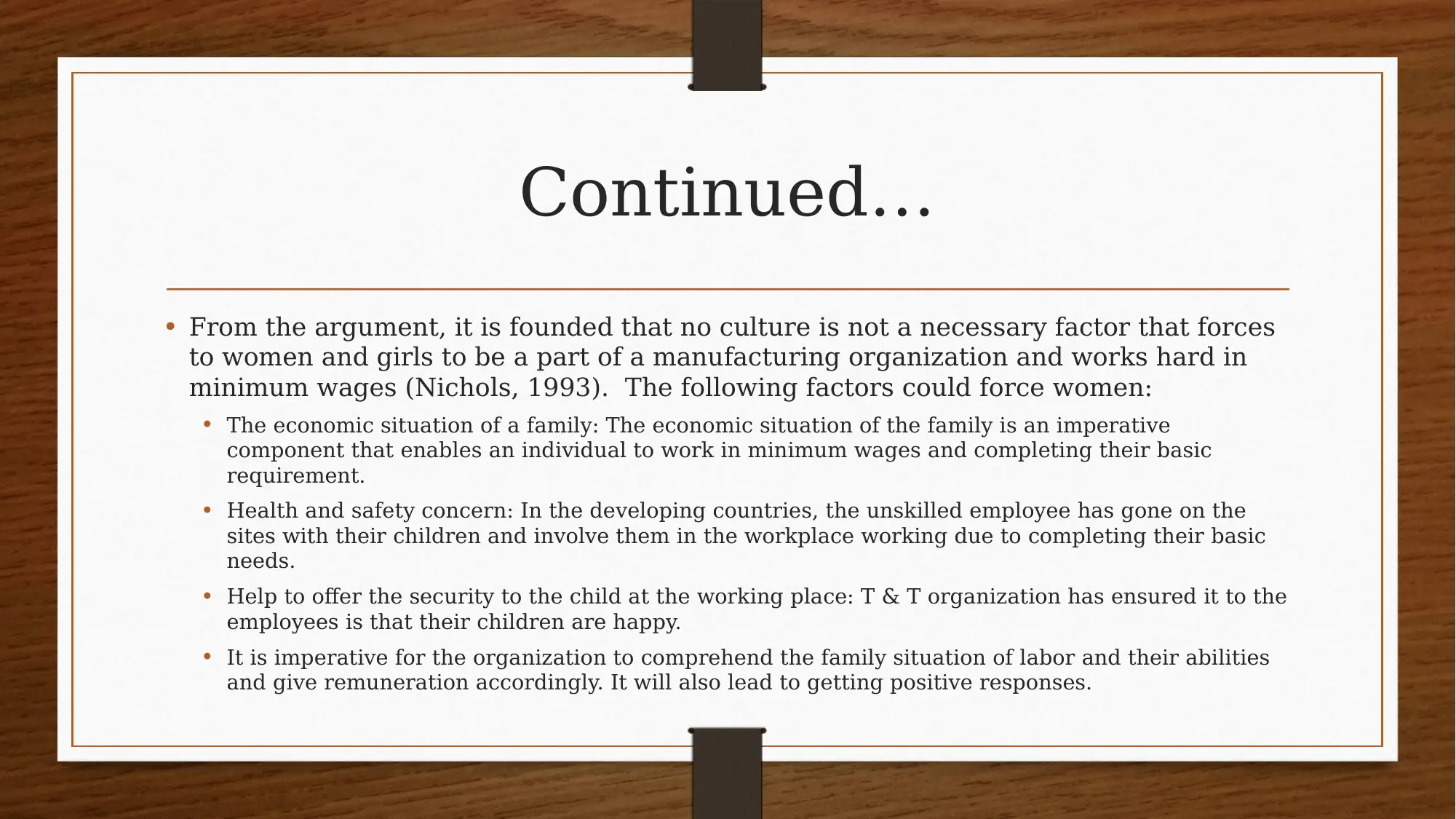
Continued…
• From the argument, it is founded that no culture is not a necessary factor that forces
to women and girls to be a part of a manufacturing organization and works hard in
minimum wages (Nichols, 1993). The following factors could force women:
• The economic situation of a family: The economic situation of the family is an imperative
component that enables an individual to work in minimum wages and completing their basic
requirement.
• Health and safety concern: In the developing countries, the unskilled employee has gone on the
sites with their children and involve them in the workplace working due to completing their basic
needs.
• Help to offer the security to the child at the working place: T & T organization has ensured it to the
employees is that their children are happy.
• It is imperative for the organization to comprehend the family situation of labor and their abilities
and give remuneration accordingly. It will also lead to getting positive responses.
• From the argument, it is founded that no culture is not a necessary factor that forces
to women and girls to be a part of a manufacturing organization and works hard in
minimum wages (Nichols, 1993). The following factors could force women:
• The economic situation of a family: The economic situation of the family is an imperative
component that enables an individual to work in minimum wages and completing their basic
requirement.
• Health and safety concern: In the developing countries, the unskilled employee has gone on the
sites with their children and involve them in the workplace working due to completing their basic
needs.
• Help to offer the security to the child at the working place: T & T organization has ensured it to the
employees is that their children are happy.
• It is imperative for the organization to comprehend the family situation of labor and their abilities
and give remuneration accordingly. It will also lead to getting positive responses.
⊘ This is a preview!⊘
Do you want full access?
Subscribe today to unlock all pages.

Trusted by 1+ million students worldwide
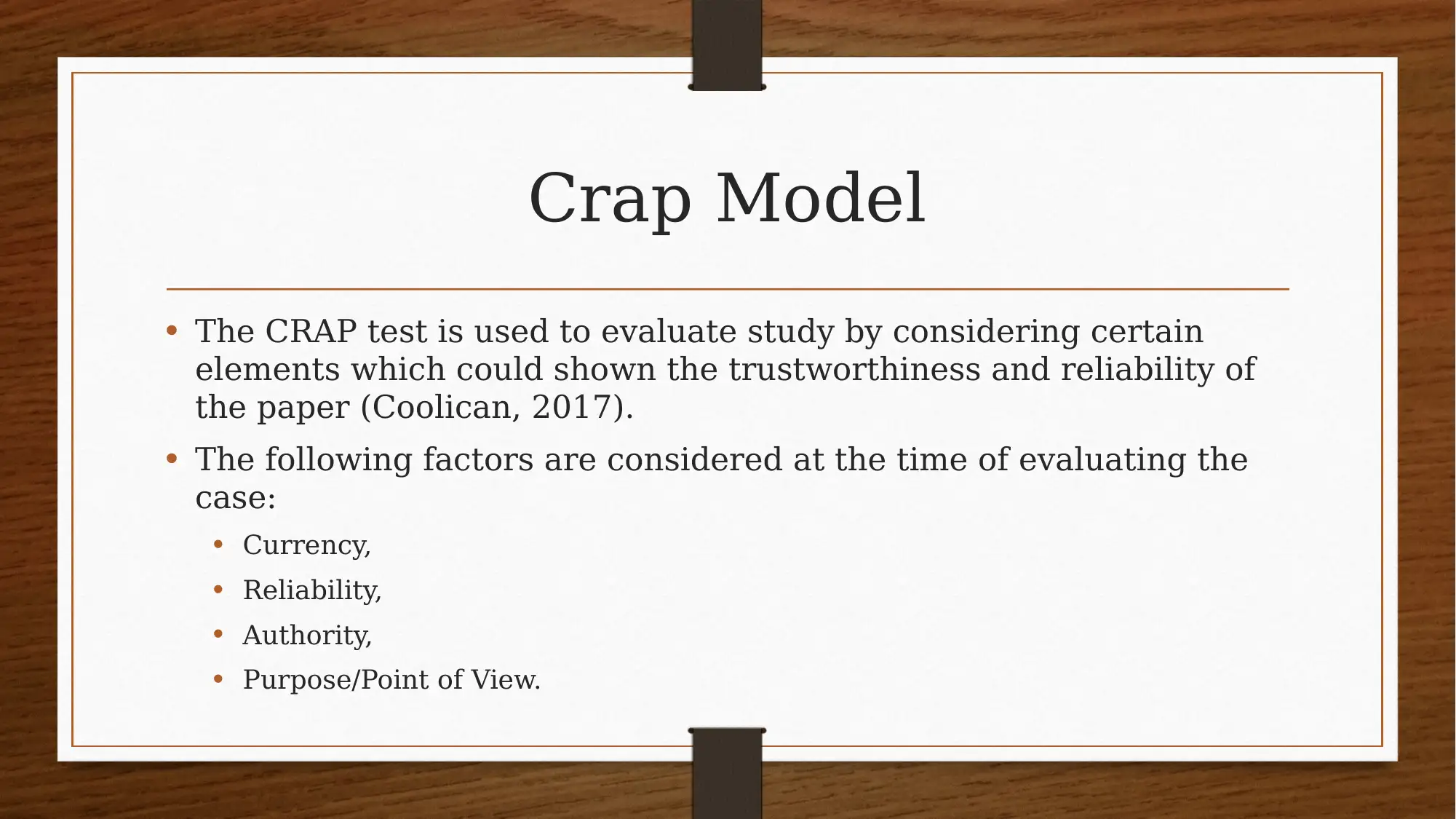
Crap Model
• The CRAP test is used to evaluate study by considering certain
elements which could shown the trustworthiness and reliability of
the paper (Coolican, 2017).
• The following factors are considered at the time of evaluating the
case:
• Currency,
• Reliability,
• Authority,
• Purpose/Point of View.
• The CRAP test is used to evaluate study by considering certain
elements which could shown the trustworthiness and reliability of
the paper (Coolican, 2017).
• The following factors are considered at the time of evaluating the
case:
• Currency,
• Reliability,
• Authority,
• Purpose/Point of View.
Paraphrase This Document
Need a fresh take? Get an instant paraphrase of this document with our AI Paraphraser
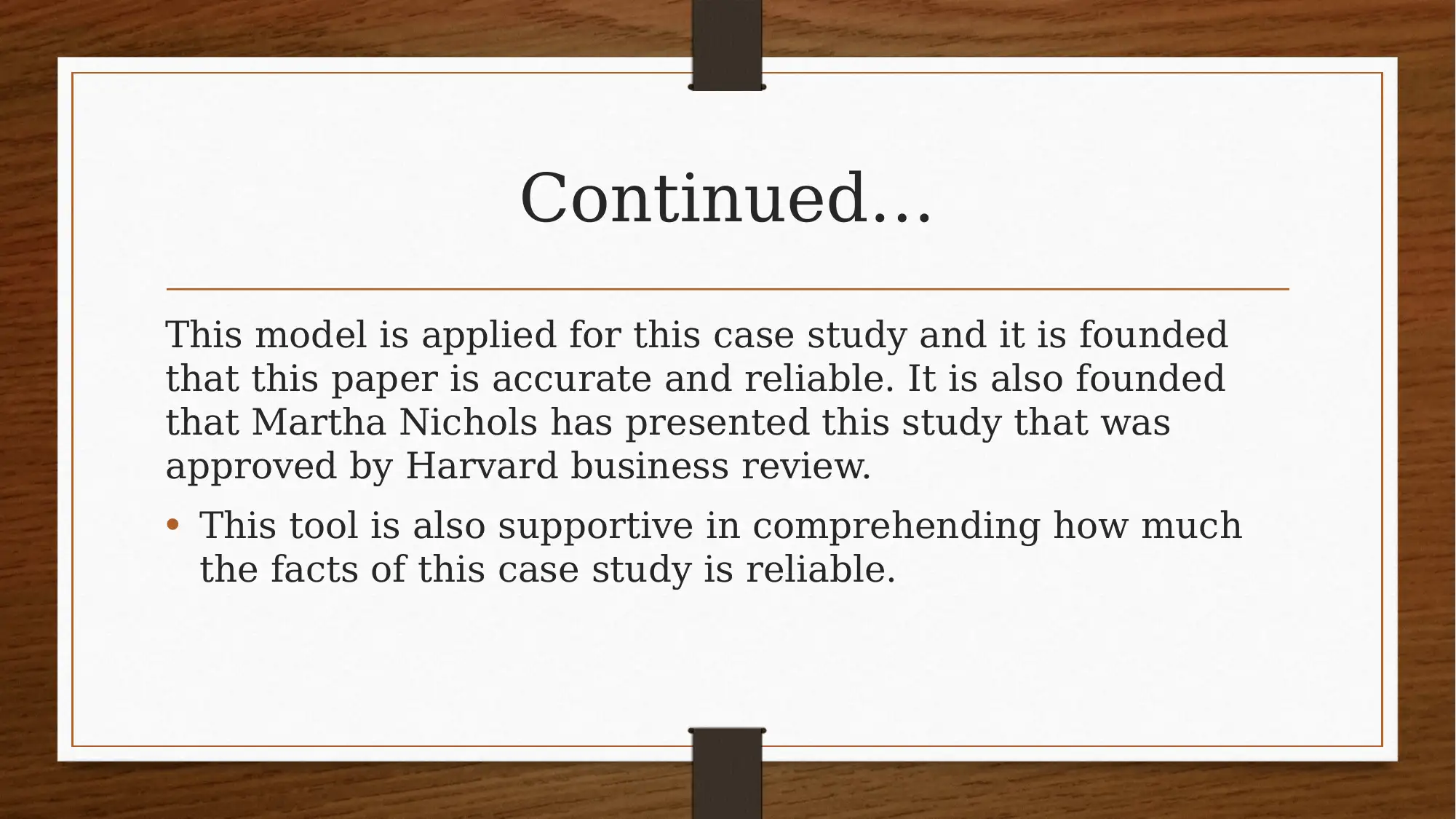
Continued…
This model is applied for this case study and it is founded
that this paper is accurate and reliable. It is also founded
that Martha Nichols has presented this study that was
approved by Harvard business review.
• This tool is also supportive in comprehending how much
the facts of this case study is reliable.
This model is applied for this case study and it is founded
that this paper is accurate and reliable. It is also founded
that Martha Nichols has presented this study that was
approved by Harvard business review.
• This tool is also supportive in comprehending how much
the facts of this case study is reliable.
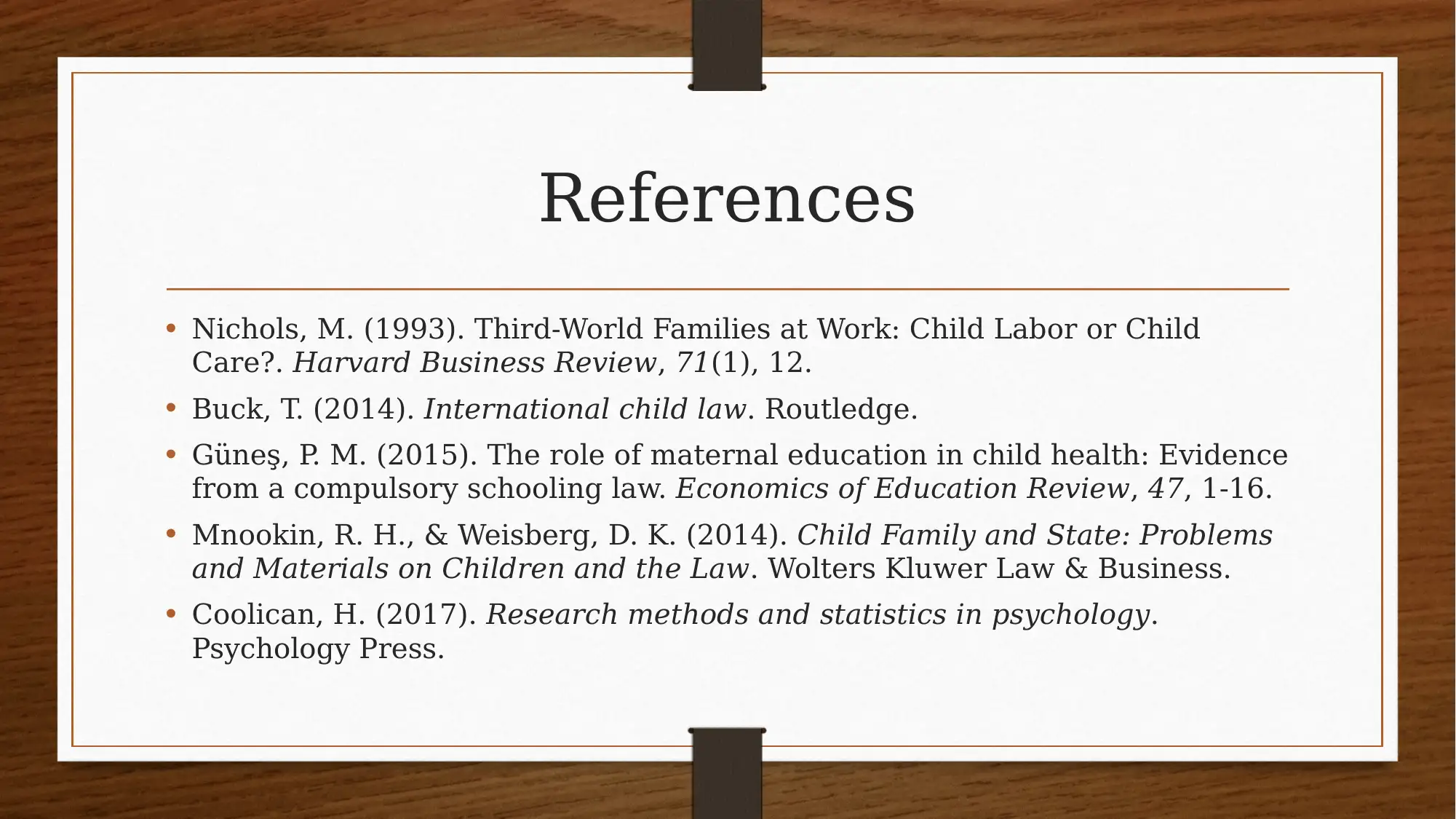
References
• Nichols, M. (1993). Third-World Families at Work: Child Labor or Child
Care?. Harvard Business Review, 71(1), 12.
• Buck, T. (2014). International child law. Routledge.
• Güneş, P. M. (2015). The role of maternal education in child health: Evidence
from a compulsory schooling law. Economics of Education Review, 47, 1-16.
• Mnookin, R. H., & Weisberg, D. K. (2014). Child Family and State: Problems
and Materials on Children and the Law. Wolters Kluwer Law & Business.
• Coolican, H. (2017). Research methods and statistics in psychology.
Psychology Press.
• Nichols, M. (1993). Third-World Families at Work: Child Labor or Child
Care?. Harvard Business Review, 71(1), 12.
• Buck, T. (2014). International child law. Routledge.
• Güneş, P. M. (2015). The role of maternal education in child health: Evidence
from a compulsory schooling law. Economics of Education Review, 47, 1-16.
• Mnookin, R. H., & Weisberg, D. K. (2014). Child Family and State: Problems
and Materials on Children and the Law. Wolters Kluwer Law & Business.
• Coolican, H. (2017). Research methods and statistics in psychology.
Psychology Press.
⊘ This is a preview!⊘
Do you want full access?
Subscribe today to unlock all pages.

Trusted by 1+ million students worldwide
1 out of 9
Related Documents
Your All-in-One AI-Powered Toolkit for Academic Success.
+13062052269
info@desklib.com
Available 24*7 on WhatsApp / Email
![[object Object]](/_next/static/media/star-bottom.7253800d.svg)
Unlock your academic potential
Copyright © 2020–2025 A2Z Services. All Rights Reserved. Developed and managed by ZUCOL.





